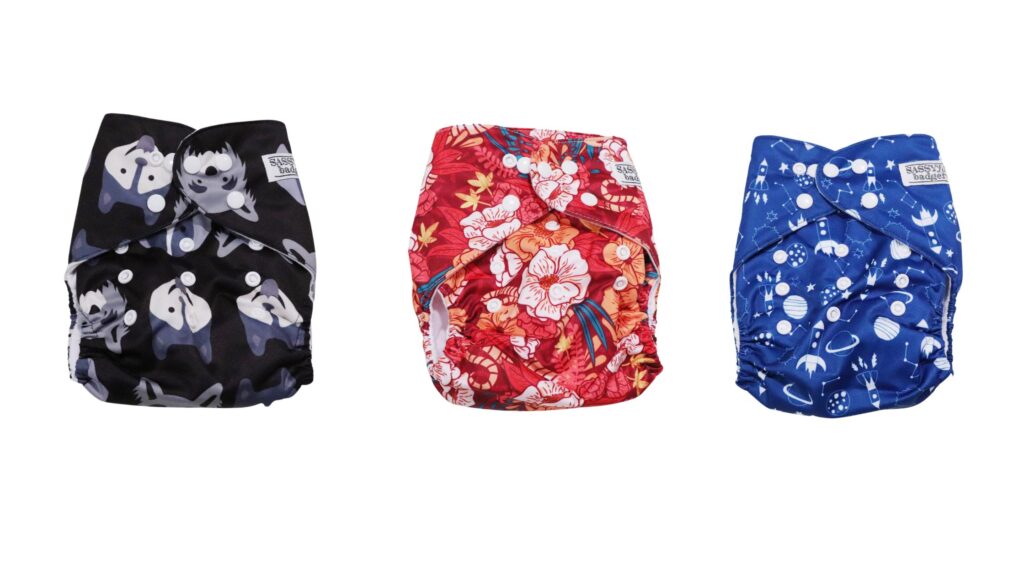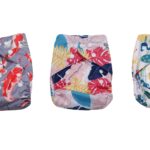Day after day, countless disposable nappies end up in landfills, where they’ll linger for centuries to come. But a wiser, more sustainable solution exists – reusable nappies! Also known as cloth nappies, they’re a brilliant choice for our planet, your wallet, and your baby’s delicate skin.
What You’ll Find in This Guide – Cloth Reusable Nappies Edition
If you’re curious about reusable nappies but feeling a bit overwhelmed, you’re in the right place. This comprehensive guide will cover the basics:
- Types of Reusable Nappies: Explore the different styles and materials available.
- Washing Routine: Learn how to easily integrate cloth nappies into your laundry routine.
- Benefits: Discover the environmental, economical, and health advantages of reusable nappies.
- Addressing Your Concerns: Get answers to common questions and worries about cloth nappies.
Let’s get started!
Types of Reusable Nappies
The world of reusable nappies might feel a bit bewildering at first, but don’t worry! Here’s a breakdown of common types:
- All-in-One (AIO): These are the most similar to disposable nappies – a waterproof outer layer combined with an absorbent inner, all in one piece. They’re super convenient but generally the most expensive option.
- All-in-Two (AI2): These consist of a waterproof outer shell and separate absorbent inserts that snap or lay inside. They’re often more affordable than AIOs and dry faster.
- Pocket Nappies: These have a waterproof outer layer with a pocket for stuffing in absorbent inserts. The type and amount of inserts can be customised for different needs.
- Fitted Nappies: These are highly absorbent shaped nappies, made entirely of materials like cotton, hemp or bamboo. They require a separate waterproof cover.
- Prefolds & Flats: Traditional nappies! Prefolds are pre-sewn with extra absorbency in the middle, while flats are large squares of fabric. Both require folding and a waterproof cover.
A word on materials: Reusable nappies come in various fabrics like cotton, bamboo, hemp, or microfibre. Each has different absorbency, softness, and drying time characteristics.
Washing Routine: It’s Easier Than You Think
One of the biggest concerns about reusable nappies is the laundry situation. Let’s dispel that worry! Here’s a simple routine making cloth nappies manageable:
Storage of reusable nappies:
- Dry Pail: Store soiled nappies in a breathable container (a laundry basket with holes works well) until wash day. No soaking necessary.
- Wet Pail: If you prefer, pre-soaking nappies is an option, but not generally required for modern nappies.
Wash Cycle for reusable nappies:
- Pre-rinse (cold): A short wash cycle to remove the bulk of the mess.
- Main Wash (warm/hot): A longer wash with a detergent specially formulated for cloth nappies.
Drying reusable nappies:
- Line drying: The most eco-friendly and budget-conscious method.
- Tumble drying (low): Okay for most nappies, check care instructions to be sure.
Tips:
- Frequency: Wash every 2-3 days.
- Detergent: Avoid harsh detergents and fabric softeners, which can damage fibres and affect absorbency.
- Boosters: Add extra absorbent inserts for naps or nighttime use.
Benefits of Reusable Nappies
Switching to reusable nappies brings a multitude of rewards for both your family and the planet. Here’s why they’re a fantastic choice:
- Environmental Impact: Drastically reduce landfill waste. Reusable nappies create less pollution during production and at the end of their lifespan.
- Cost Savings: While there’s an upfront cost, using reusables saves you a significant amount of money in the long run compared to continually buying disposables.
- Healthier for Baby: Many parents find that natural fabrics in cloth nappies reduce nappy rash. Plus, increased breathability promotes overall skin health.
- Cuteness Factor: Reusable nappies come in adorable prints and colours, adding a touch of fun to diapering.
- Potty Training Potential: Some children potty train earlier with cloth nappies, as they can more easily feel the sensation of being wet.
A Note About Sustainability: Even with washing, reusable nappies still have a smaller environmental footprint than disposables. Choose line-drying whenever possible to minimize your impact even further.
Addressing Common Concerns about Reusable Nappies
It’s completely natural to have questions when considering a switch to cloth nappies. Let’s address some of the most frequent concerns:
- “Won’t they leak more often?” With a good fit and the right absorbency, modern cloth nappies are just as reliable as disposables. Finding what works for your baby may take some trial and error.
- “Isn’t the constant washing a massive chore?” Reusable nappies do add an extra laundry load, but streamlined routines make it manageable. Plus, no more emergency nappy runs!
- “Aren’t they bulky on my baby?” Modern cloth nappies are designed to be as trim as possible. Many parents are surprised by how streamlined they actually are.
- “What about when we’re out and about?” Cloth diapering on the go is surprisingly easy! Bring a wet bag for soiled nappies and fresh ones for changes.
- “It seems complicated; I won’t know where to start!” Don’t be overwhelmed! Online resources, nappy communities, and helpful retailers provide tons of support, making the transition a breeze.
Remember: Switching to reusable nappies doesn’t have to be all or nothing. Even using them part-time makes a positive difference!
Your Reusable Nappy Journey Begins!
The choice to go with reusable nappies is a powerful one. You’re taking a step towards a greener future, a healthier baby, and even saving money in the long run. While it may seem like a change, remember, thousands of parents successfully cloth diaper every day, and you can too!
Don’t hesitate to seek out support from online communities, local shops, or even friends who’ve embraced reusable nappies. This journey may start with small steps, but every cloth nappy change you make creates a positive ripple effect.

